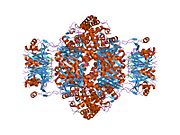GTP cyclohydrolase I
Ensembl | |||||||||
|---|---|---|---|---|---|---|---|---|---|
| UniProt | |||||||||
| RefSeq (mRNA) | |||||||||
| RefSeq (protein) | |||||||||
| Location (UCSC) | Chr 14: 54.84 – 54.9 Mb | Chr 14: 47.39 – 47.43 Mb | |||||||
| PubMed search | [3] | [4] | |||||||
| View/Edit Human | View/Edit Mouse |
GTP cyclohydrolase I (GTPCH) (
Gene
GTPCH is
Clinical significance
At least 94 disease-causing mutations in this gene have been discovered.
Function
ExPASy NiceZyme view | | ||||||||
| KEGG | KEGG entry | ||||||||
|---|---|---|---|---|---|---|---|---|---|
| MetaCyc | metabolic pathway | ||||||||
| PRIAM | profile | ||||||||
| PDB structures | RCSB PDB PDBe PDBsum | ||||||||
| Gene Ontology | AmiGO / QuickGO | ||||||||
| |||||||||
The
GTPCH (GCH1) and tetrahydrobiopterin were found to protect against cell death by ferroptosis. Tetrahydrobiopterin (BH4) acts as a potent, diffusable antioxidant that resists oxidative stress and enables cancer cell survival.[9]
See also
- Guanosine triphosphate (GTP)
- Tetrahydrobiopterin (THB, BH4)
- folic acid → folate)
References
- ^ a b c GRCh38: Ensembl release 89: ENSG00000131979 – Ensembl, May 2017
- ^ a b c GRCm38: Ensembl release 89: ENSMUSG00000037580 – Ensembl, May 2017
- ^ "Human PubMed Reference:". National Center for Biotechnology Information, U.S. National Library of Medicine.
- ^ "Mouse PubMed Reference:". National Center for Biotechnology Information, U.S. National Library of Medicine.
- ^ a b "Entrez Gene: GCH1 GTP Cyclohydrolase 1 (DOPA-Responsive Dystonia)".
- PMID 31819097.
- S2CID 13117236.
- ^ "Patient registry".
- PMID 31989025.
Further reading
- Voet JG, Voet D (2004). Biochemistry. New York: J. Wiley & Sons. ISBN 0-471-39223-5.
External links
- GTP+Cyclohydrolase+I at the U.S. National Library of Medicine Medical Subject Headings (MeSH)
- GeneReviews/NCBI/NIH/UW entry on GTP Cyclohydrolase 1-Deficient Dopa-Responsive Dystonia
- Overview of all the structural information available in the PDB for UniProt: P30793 (Human GTP cyclohydrolase 1) at the PDBe-KB.




